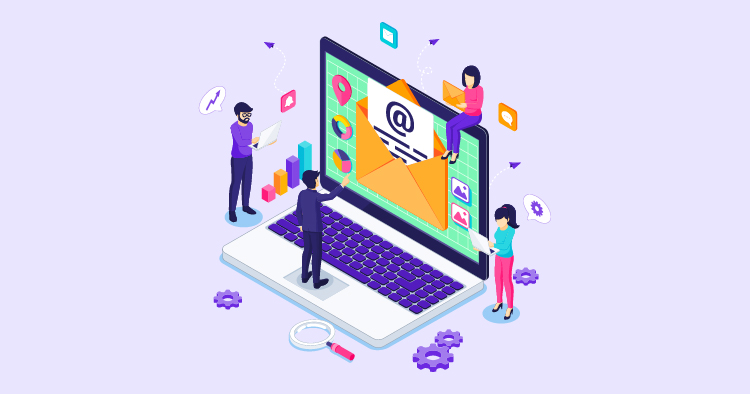Email marketing is a vital strategy for businesses looking to engage with their audience and boost sales. The secret to success lies in crafting a plan that makes your messages stand out in your customers’ crowded inboxes. You need to understand your audience, create content that speaks directly to them, and use automated tools effectively to do this. This article will delve into some top email marketing strategies that can foster strong customer relationships and increase profits. These tips are helpful whether you’re running a small shop or a multinational company, and they’ll guide you in sharpening your email marketing tactics for improved outcomes.
What is an Email Marketing Strategy?
An email marketing strategy is a plan that guides how a business communicates with its audience through email. It’s all about deciding how to reach out to your customers and potential customers, sharing news, offering value, and fostering a community among your subscribers.
At its core, this strategy is about building genuine connections with people. You’re not just blasting out information; you’re talking to individuals one-on-one. Whether you share updates about your products or give tips related to your field, the aim is to offer something your readers find helpful and engaging.
A good email marketing strategy is more than just sending emails. It requires understanding your audience’s preferences and behaviors. This insight helps you tailor your messages to their interests and needs.
Remember, an effective email marketing strategy is flexible. It should evolve as your audience changes and as new trends emerge. This way, you can keep providing value and stay relevant in your customers’ inboxes.
Why do You Need an Email Marketing Strategy?
A solid email marketing strategy is essential because it lets you talk directly to your audience. It’s an effective way to connect with people, strengthen bonds, and keep your brand in their minds.
Email marketing stands out for being cost-effective. With a well-written email, you can reach many people and motivate them to act without breaking the bank. This affordability makes it appealing for all types of businesses.
With email, you can also segment your audience based on what they like and how they act. This lets you send messages that resonate with each group. When emails feel relevant, people are more likely to read and engage, which means better results for your efforts.
Struggling with Digital marketing? Book Your Free Strategy Session!
- 30-Minutes Session
- Expert Insights
- Data-Driven approach
- Optimized Strategies for Your Goals
Finally, a robust email marketing strategy helps build a community around your brand. Sending regular emails packed with value can turn casual readers into loyal fans who eagerly await your messages and are more willing to support your business.
How to Create a Winning Email Marketing Strategy
When crafting emails as part of your marketing strategy, consider them the digital equivalent of a storefront window—they must be inviting and display what you’re all about. Start with a clean, eye-catching design to make your emails stand out. Use visuals that captivate your audience and a layout that effortlessly guides them through your message.
Keep your brand at the forefront by using your logo, consistent colors, and fonts that are part of your brand’s style. This helps with recognition and builds trust as subscribers become familiar with your brand’s visual identity.
Readability is key. Choose fonts that are easy to read and leave plenty of white space around text and images. This approach helps to deliver your message without overwhelming your readers.
Before you hit send, preview your emails on various devices to ensure they look great on any screen. A responsive design ensures everyone has a positive experience, no matter how they access your email.
Include a Catchy Email Signature
Your email signature is like a business card at the end of your message—it’s a chance to make a professional and lasting impression. Start with the basics: your contact information. Then, inject some of your brand’s unique flair to make it stand out.
Add social media icons linked to your brand’s profiles to encourage readers to connect with you on other platforms. This can help increase your audience’s engagement with your brand beyond the inbox.
Don’t miss the opportunity to include a call to action in your signature. Whether promoting a new product, inviting subscribers to a webinar, or sharing your latest content, a CTA can be a powerful tool for encouraging further interaction.
Keep the signature design clean and uncluttered. You want to showcase your brand’s personality while ensuring critical information is straightforward to find.
Segment Your Audience
Segmenting your audience means analyzing your customers and dividing them into groups that share similar traits. For example, you might group them by what they like to buy or how often they shop. This helps you talk to each group in a way that they find exciting and relevant, which usually makes them more likely to pay attention to what you have to say.
When you combine similar customers, you can create messages that feel more personal. This can make customers feel like you understand them, which can build a stronger connection between them and your brand.
Segmenting also helps you see what’s working and what’s not. By examining how different groups respond, you can determine where to focus your energy to grow your business and fix any weak spots.
Remember that what your customers like and need can change, so it’s essential to keep checking and adjusting your groups to ensure your messages stay fresh and hit the mark.
Personalize Your Content
When you send an email, using the person’s name is an excellent start to make them feel like you’re talking directly to them. But there’s more to personalization than just names.
Take it further by changing your content to match what each person likes or has done with your brand. This could be based on things they’ve bought, pages they’ve visited on your website, or interactions with your emails. When content feels made just for one person, it can make them feel unique and more likely to engage with your brand.
You can also change your emails to show different things to different groups of people. This means everyone gets the information that’s most useful to them. When emails are super relevant, people are more likely to read and act on them.
Personalizing your email marketing is not a one-time task. It’s crucial to keep gathering information and learning from it. This ongoing process helps you tweak your strategies, making your emails more relevant and impactful. Think of it as a continuous improvement of your approach. The more you understand your audience, the better your content matches their interest. This can lead to more people engaging with your emails and taking action.
Use Short Subject Lines
Short subject lines can be very effective in getting people to open your emails. Make an excellent first impression with concise and intriguing subject lines. Using words that suggest urgency or excitement can encourage quick opens. It’s also important to be clear about what the email contains to maintain trust with your subscribers.
Adding a personal touch, like using the recipient’s name or mentioning a recent interaction, can make your email stand out in a crowded inbox.
Struggling with Digital marketing? Book Your Free Strategy Session!
- 30-Minutes Session
- Expert Insights
- Data-Driven approach
- Optimized Strategies for Your Goals
Don’t forget to try out A/B testing for your subject lines. This lets you compare different versions to determine which ones your audience prefers, helping you improve your future emails.
Automate Your Campaigns
Using automation can make your email marketing much more accessible. It ensures your messages get to your subscribers at the best times, keeping the conversation alive. For instance, sending an automated welcome email or a birthday message shows you care and doesn’t require constant attention from your team.
Many automation tools also provide analytics. This means you can better understand how people interact with your emails and see how well your campaigns are performing. These insights are valuable for making smarter marketing choices.
Remember, though, that automation should be used wisely. Aim for a balance to avoid overwhelming your subscribers with emails. Always send out high-quality content to maintain your brand’s reputation.
Leverage Social Media
Combining social media with email marketing can significantly increase the effectiveness of your campaigns. By placing social media icons in your emails, you make it easy for subscribers to find and follow you on these platforms, which helps in building a more robust online community.
Another smart move is to include content from your social media accounts in your emails. Showcasing what customers say or do with your products builds trust and shows that you value their input.
You can also use social media to get more people to sign up for your emails. Offer special deals or valuable information as a sign-up bonus and promote it on your social accounts. This can entice a broader audience to join your email list.
Lastly, social media is a goldmine of information. Monitor what your audience is talking about and use these insights to make your email content more relevant and engaging.
Optimize for Mobile
With most people reading emails on their phones, your emails must look good and work well on mobile devices. Start by using a responsive design that adjusts to different screen sizes. This ensures that your email will be easily read and navigated no matter what device someone uses.
It’s also essential to keep loading times quick. Optimize your images and streamline your design to ensure your emails load fast. People might get frustrated and delete them before reading if they don’t.
When it comes to the actual content, keep it short and sweet. People prefer messages that get to the point but still provide all the necessary information.
And don’t forget about your call-to-action (CTA) buttons. They need to be big enough to tap easily on a small screen. If users find it difficult to click, they might not take the action you’re hoping for.
Track the Right Metrics
Focusing on the most informative metrics is essential when evaluating your email campaigns. Start by checking how many people are opening your emails. This open rate can tell you if your subject lines are grabbing attention and your audience is interested in what you say.
Then, look at your click-through rates. This shows whether your content is hitting the mark with your readers and getting them to interact with your emails. If you see a lot of clicks, that’s a good sign that your messages are engaging.
Keep an eye on the number of people who unsubscribe from your emails, too. A sudden increase in this rate can be a warning that you might need to rethink what you’re sending or how often you’re emailing people.
Finally, pay attention to your conversion rate. This is all about whether people are doing what you hoped they would after reading your email, like buying something or signing up for an event. It’s a direct measure of your email campaign’s effectiveness.
Optimize CTAs
Creating compelling Call-to-Action (CTA) buttons is critical to getting results from your email campaigns. You want to use words that inspire people to act, which can lead to more engagement and conversions.
Place your CTAs where they’re easy to find and click on. They should stand out in your email to draw people to them.
Try different looks for your CTAs, like changing their color, shape, or size. You might find that a particular style works better to get people’s attention and encourage them to click.
It’s also essential to keep your emails focused. Stick to one primary CTA to keep your message clear and prevent confusion about what you want the reader to do. Too many CTAs can be overwhelming and might hurt your campaign’s effectiveness.
A/B Testing
A/B testing is a powerful tool for improving your email marketing. It starts with sending two variations of an email to see which one gets better results. This way, you’re making choices based on solid data, which can make your campaigns more effective.
When testing, it’s best to change just one thing at a time, like the subject line, the content, or the call to action. This makes it easier to see what’s working.
Testing your emails on enough people to get reliable results is also essential. This helps you make the right changes.
Keep using what you learn from A/B testing to improve your future emails. Over time, this will help you reach your goals more effectively.
Add Visuals
Adding pictures or videos to your emails can make them more exciting and memorable. Visuals break up the text and can make your message more engaging.
Choose visuals that complement your message. Infographics, images, or videos can sometimes convey your point better than words alone.
Make sure your visuals fit with your brand’s style and message. Consistent visuals help people recognize and trust your brand.
Lastly, ensure your visuals look good on all devices and don’t take too long to load. This gives everyone a good experience no matter how they’re looking at your email.
Focus on the Best Time to Send Emails
Finding the right time to send emails is crucial for getting your audience’s attention. Start by testing different times to see when your emails get the most opens and clicks. Your audience’s habits can vary, so what works for one business might not work for yours.
Also, consider how often you send emails. You want to keep your audience interested without sending so many emails that they get annoyed. Finding this balance is critical.
Consider special times of the year, like holidays or significant events. Sending emails that coincide with these times can increase engagement.
Lastly, using tools that schedule emails for you can make sure your messages get sent out on time. This helps you stay regular with your emails and can lead to better results.
Address Inactive Subscribers
Getting back in touch with people who aren’t opening your emails can make a big difference. Start by putting these subscribers into their group so you can send them particular messages to win them back. This can make them feel unique and more likely to respond.
It’s also a good idea to ask them why they stopped engaging. Their feedback can help you improve your email campaigns and prevent more subscribers from losing interest.
Try offering something tempting, like a discount or a sneak peek at new products. This can get their attention and bring them back to your brand.
If none of this works, you might need to remove them from your list to keep it healthy. It’s tough to say goodbye, but having a list of people interested in what you’re saying is better for your email campaigns in the long run.
Contests and Giveaways
Hosting contests and giveaways can be an exciting way to get people more involved with your email marketing. They’re a powerful tool for encouraging new subscribers because everyone loves the chance to win something. To ensure you’re getting people’s attention, pick prizes that reflect your brand’s values and that your audience will genuinely want. This makes it more likely that they’ll participate and enjoy the experience.
Don’t limit the promotion of these events to your emails. Spread the word on social media and other platforms to reach more people and create excitement about your brand. After the contest is over, keep the conversation going. Let everyone know who won, and consider offering something for those who didn’t win this time. This can help you build lasting relationships and keep your audience engaged.
Final Thoughts
After delving into the intricacies of email marketing, it’s evident that a well-thought-out strategy can drive business growth. Personalization, segmentation, and intelligent automation aren’t just trendy terms; they are fundamental to crafting emails that get results. It’s essential to keep testing and refining your approach, using data to guide you. Staying current with these best practices will help your email marketing strike a chord with your audience and positively impact your business’s achievements.



